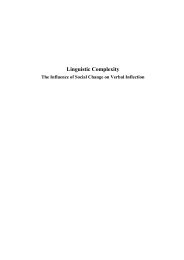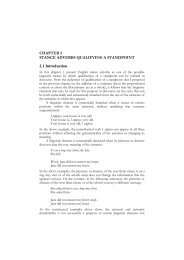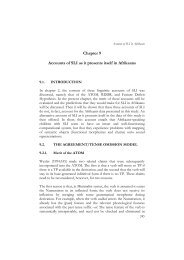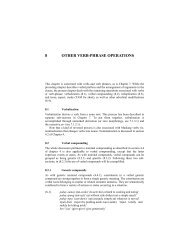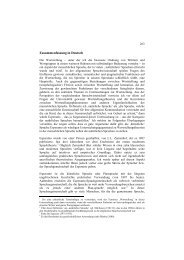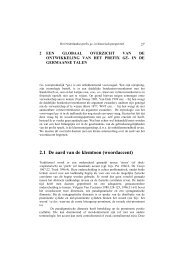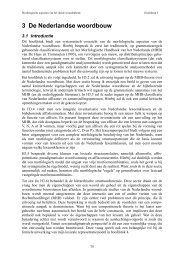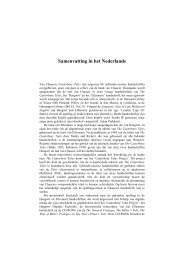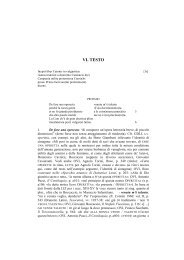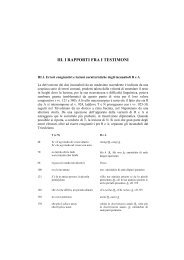Chapter 2 - LOT publications
Chapter 2 - LOT publications
Chapter 2 - LOT publications
You also want an ePaper? Increase the reach of your titles
YUMPU automatically turns print PDFs into web optimized ePapers that Google loves.
<strong>Chapter</strong> 2<br />
But if the causee (‘woman’ in 8a) is a nominal element and not a pronominal element,<br />
then the patient (‘light’ in 8a) which is sentence initial can be marked for a<br />
nominative case as shown below:<br />
8a. ibsaa-n dubartii barbaačč-is-a<br />
light-NOM woman look for- CAUS 1 -3M:IMPF<br />
‘A woman needs light.’ / lit., ‘It makes woman look for light.’<br />
8b. dubartii-n bišaan barbaad-de<br />
woman-NOM water look for-3F:PF<br />
‘A woman looked for water.’<br />
9a. biiftuu-n baa-te<br />
sun-NOM rise-3F:PF<br />
‘The sun rose.<br />
9b. biiftuu-n nama barbaačč-is-a<br />
sun-NOM man look for- CAUS 1 -3M:IMPF<br />
‘Human being needs sun.’/lit., ‘It makes human being need sun.’<br />
Although they are marked for nominative case, initial constituents ibsaa-n ‘light’<br />
and biiftuu-n ‘the sun’ are not the subjects of (8a) and (9b) as it is clear from the<br />
third person masculine agreement on the verb; ‘light’ is masculine while ‘sun’ is<br />
feminine but has no subject agreement on the verb which has a 3M ending, despite<br />
the fact that the nominal ‘sun’ has nominative case in (9b). In constructions with<br />
impersonal passives we will encounter similar cases of sentence initial consituents<br />
being marked by the nominative but not being subject.<br />
In subjectless causative structure the causer is not present in the event. In this type of<br />
structure, word order is strict and not free: the patient precedes the causee which is<br />
followed by the causative verb. In most cases such event is expressed by imperfective<br />
aspect. Similar to impersonal passives, the subject agreement element on the<br />
verb is the third person masculine singular (see <strong>Chapter</strong> 7). Subjectless causative<br />
verbs are single causatives; they have only one single causative morpheme attached<br />
to their bases. These causative verbs typically occur with verbs of desire and we will<br />
see that in Anharic they are restricted to verbs of desire. Subjectless causative verbs<br />
such as ɗaraa-sis- ‘long for’, haww-isiis- from haww- ‘to wish for’, ɗara-sis-<br />
from ɗaraʔ- ‘long for’ and kajel-sis- from kajel- ‘want’ do not allow expression of<br />
a causer in other constructions while the verb barbaačč-is- ‘make look for’ does.<br />
Verbs such as ɗaraa-sis- ‘make long for’ differ from barbaačč-is- ‘make look<br />
for’ because of their lexical properties in the sense that the former is purely a verb of<br />
desire while the latter can be a verb of desire and causative verb as shown in (10).<br />
18



